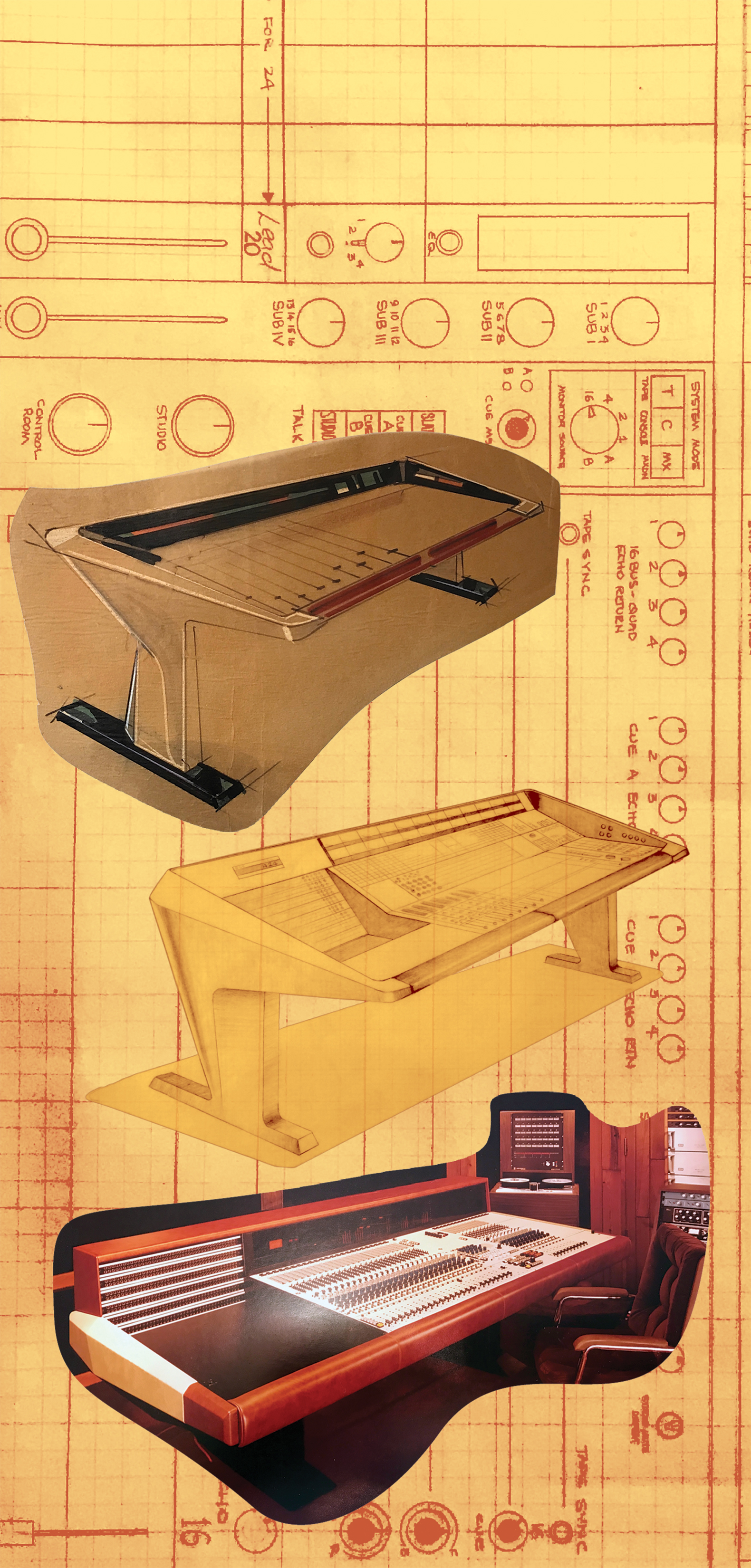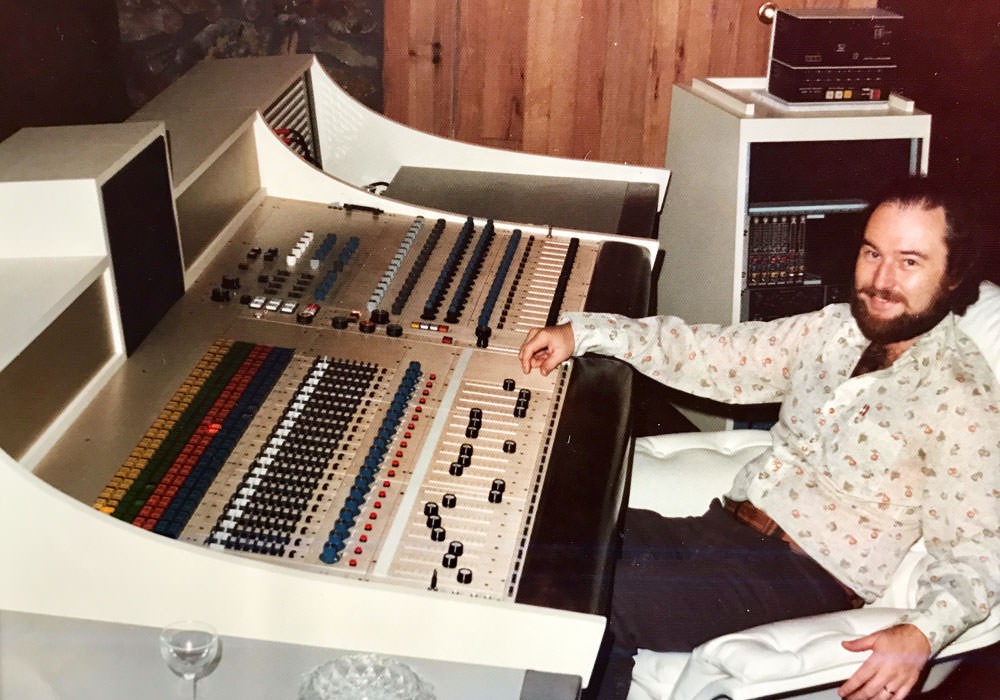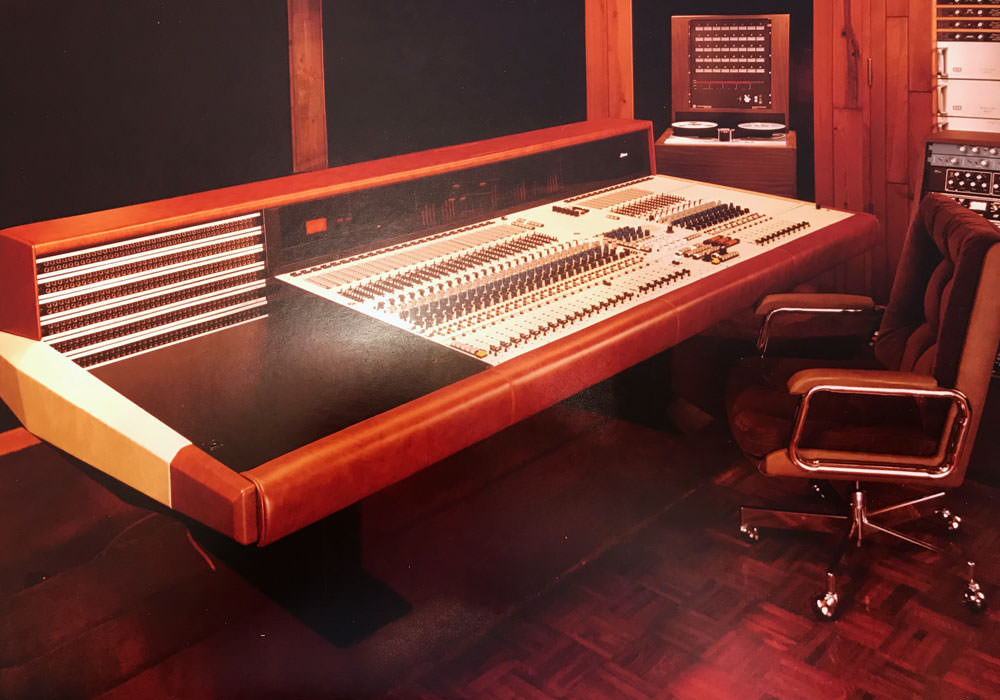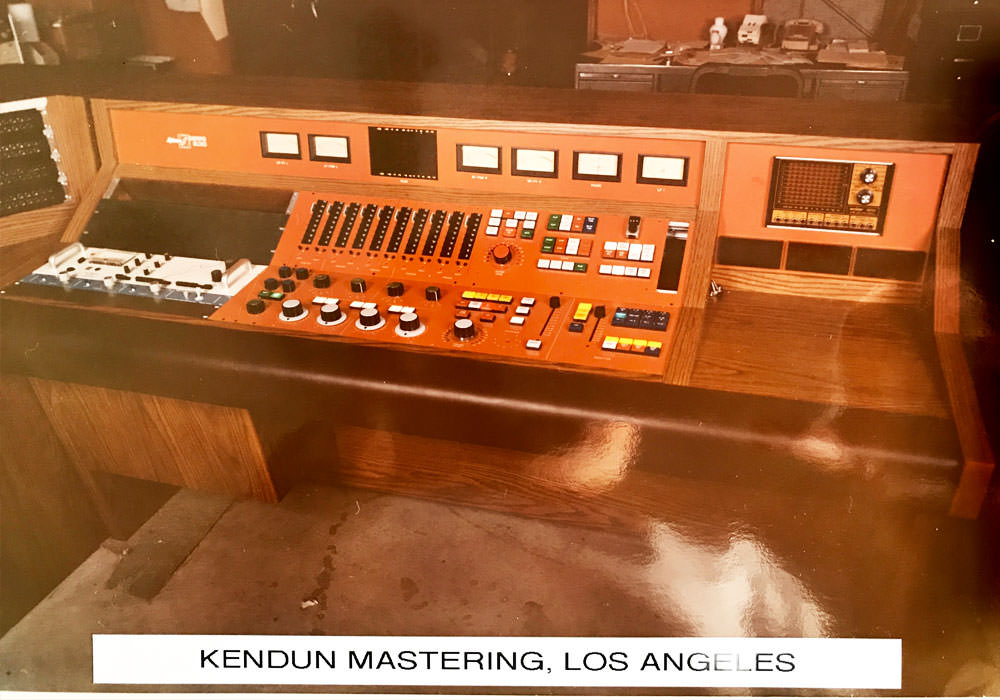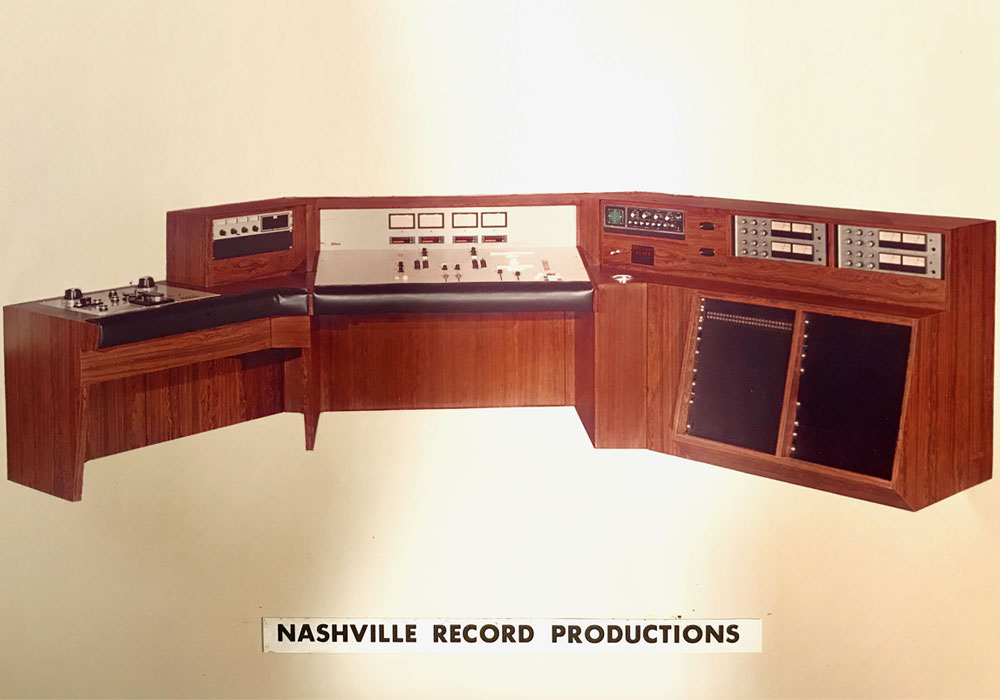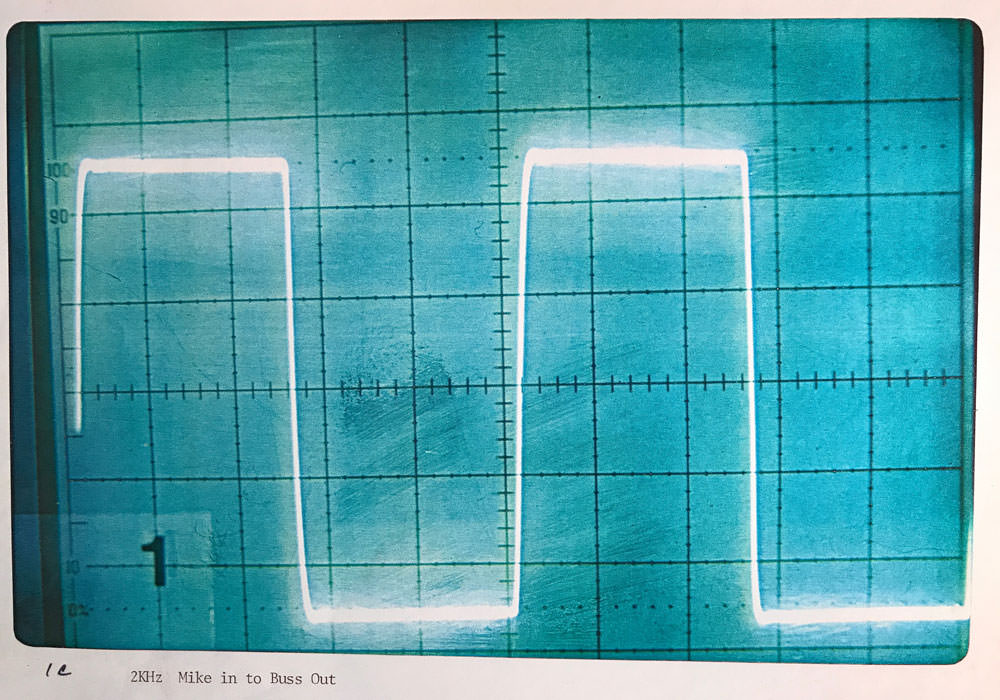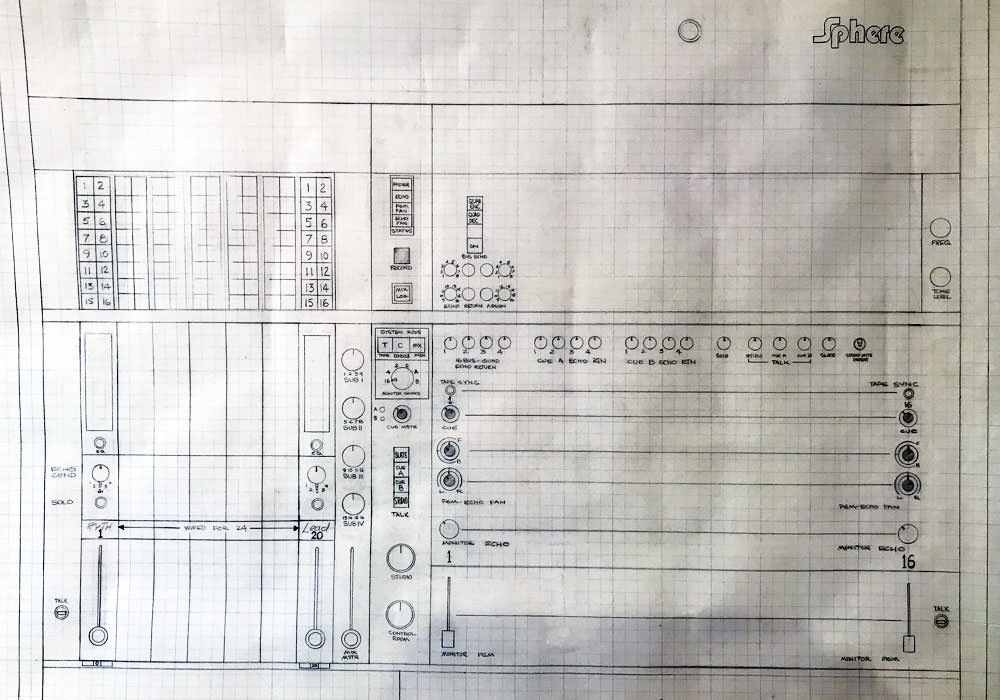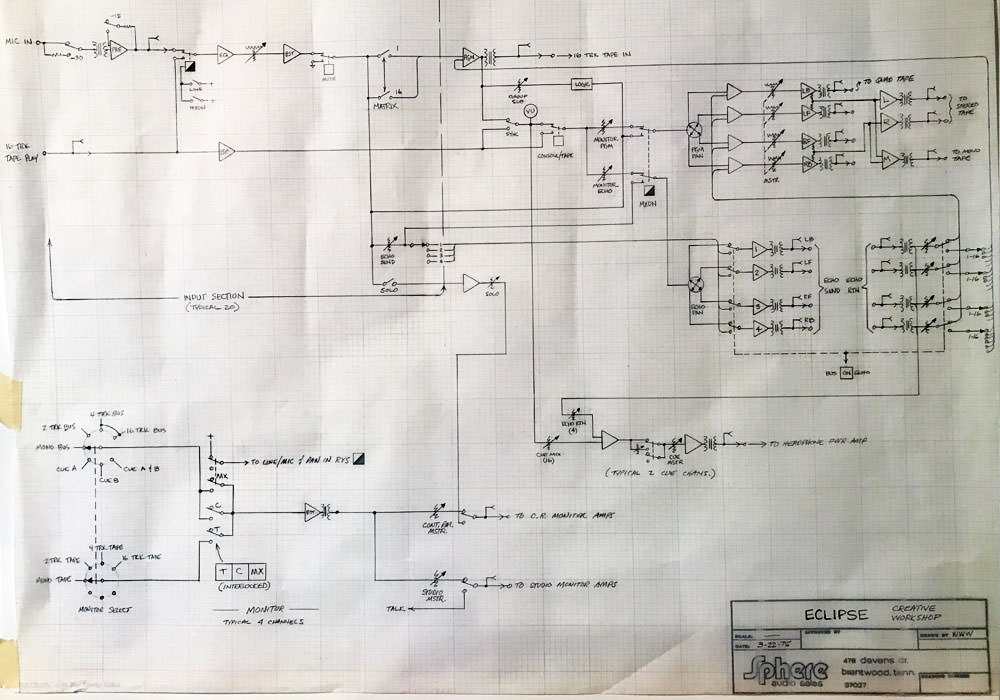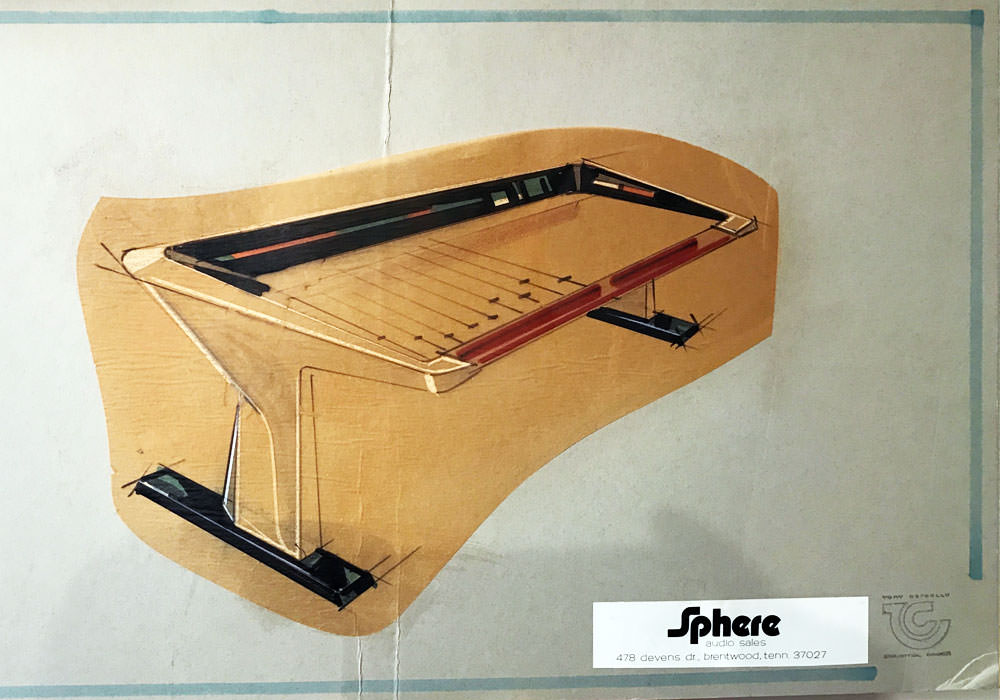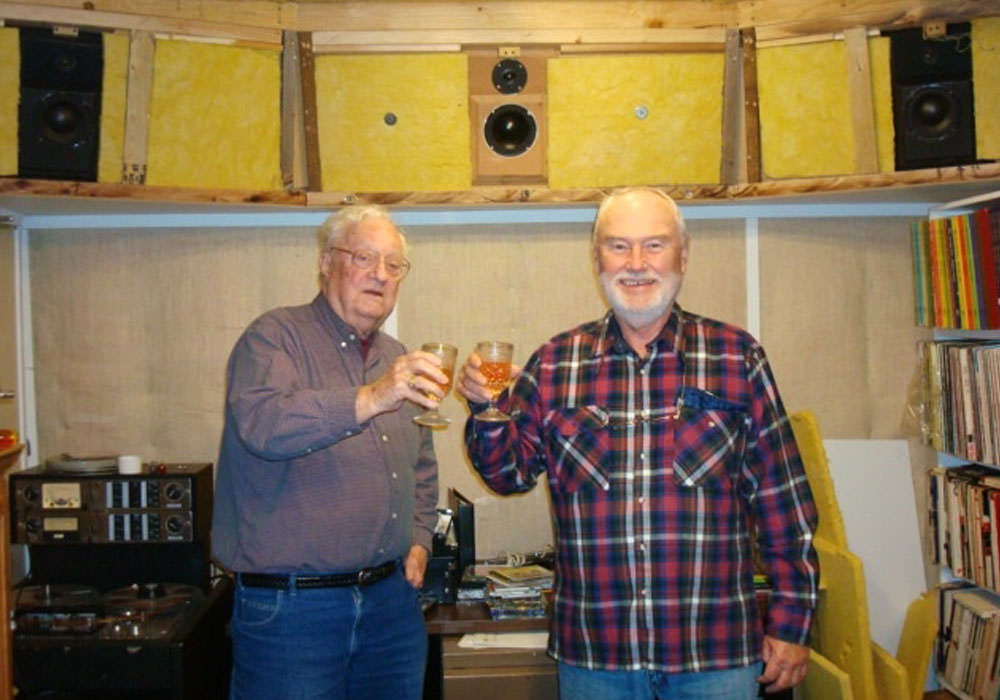Lead photo text: Author Wally Wilson behind the first Sphere multitrack console at Creative Workshop, Nashville, TN, 1976.
Recently there's been renewed interest in Sphere consoles, and the history of Sphere Electronics. With Don McLaughlin having sadly passed away in 2014, I guess I'm the guy left to tell the original story. Don and I formed Sphere Electronics in 1973. This is my personal account of how it happened.
Don was extremely bright in every way, especially with electronics, philosophy, and business. I found Don to be very honest and easy to deal with. He was hard working and inventive, but he loved to have fun. His passion was classical music; he was very knowledgeable of the subject, as well as critical of the quality of recordings. Don built his own tape recorder, a portable 3-track, 1/2-inch, and he would sneak into Royce Hall at UCLA to secretly hang small Stephens condenser microphones over the orchestra and record without anyone's permission. He hated limiters and compressors, so a lot of headroom was his answer. The recorder had mic preamps built in, and that was it. He'd go home and play it back on the same machine, on his 3-channel system with no EQ or futzing around, and it would sound spectacular! Many musicians from the L.A. Philharmonic would come to his house after a performance and listen to their work, and the booze would flow.
But to tell this story, it's necessary to first talk about Electrodyne Corp., a company Don McLaughlin started on his own. My involvement began when I was hired at Electrodyne, in its early days, around 1967. I needed a job badly, and was hired as a wireman. I was promoted to technician in a few days, and when the Console Manager, Johnny Robbins, found out I could operate test equipment - signal generators and oscilloscopes - I was soon promoted to Project Manager, then Lead Project Manager, and, after a few years, to Manufacturing Manager. Don was the President of Electrodyne, and he and I had only spoken a few times.
I reported to the Vice President. It was hard work sometimes, working 24 hour days more than once. Console delivery dates had to be met, not only for customer's schedules but to receive payments to meet payroll. We nearly always had cash flow problems, and were finally bought by MCA Corporation as a tax deduction for them. We were later reborn as the Cetec Corporation, and at this point Don was bought out and departed the scene. I was burned out from trying to run manufacturing through these mergers while attempting to maintain my position. I was supervising about 50 people, and didn't want that pressure anymore. I'd learned a lot but I wanted out, so I resigned from my job there.
I moved to Memphis and went to work for one of our dealers, W&W Distributing. Leon Sides at W&W had sold several of our consoles locally. Meanwhile Cetec Corp. kept calling me to come back to work for them. They'd built five 16-channel consoles, Series 2000, and hadn't sold them. They wanted me to help. After nine months in Memphis, my gig there wasn't going well, so I agreed to go back to Cetec Corp.; but instead of L.A. I opened an office in Nashville. I did sell those five consoles, but it was clear they weren't going to build any more. I was looking at the end of the trail at Cetec Corp. Meanwhile, I'd also developed some ideas about a new console design, including a new name: Sphere. It was an original name, and I thought it had a freshness, as well as a certain appeal.
I'd heard Don was starting a new console company, so I called him and asked if we could meet to discuss my ideas, as well as what he was doing. He was very amiable about getting together. We were face to face in an L.A. restaurant within a few days. He was working on new circuits and module ideas, but had not yet gotten to a console design stage. Here I was with console design ideas, and Don was receptive to doing something together. I asked him what he was going to call his new company. He said, "Mac Electronics," with the Mac from McLaughlin. It sounded terrible to me, and I suggested Sphere Electronics. He liked it and I breathed a big sigh of relief. I suggested we work together, and that I would provide my plans at no cost for no salary, in exchange for a 10 percent ownership in his company. I would start a manufacturer's representative sales company in Nashville, with an exclusive contract to represent Sphere in the eastern United States. I would call my company Sphere Audio Sales, and I would also represent other - non-competitive with Sphere - professional audio lines. He wouldn't own any part of my company; I would work on a straight commission, with no salary or expenses, except that if I created literature for Sphere he'd compensate for printing, photography, and so on. I would also commission the consoles I sold, meaning I'd check them out completely, debug and repair, teach the customers how to operate them, and live with warranty repair for one year with him, providing spare modules and parts at no cost to me. I knew Sphere's reputation would be absolutely critical if we were to succeed. I also knew that if a console were made with the quality we envisioned, as well as properly installed and debugged, it wouldn't be a problem to get through a year and beyond.
I flew back to Nashville, resigned my job from Cetec Corp., and got to work on drawings to show Don. This was very exciting and scary. I now had no income, with house payments and a family to support, and just a little bit saved. Now I had to sell some consoles! To expedite things, I needed to spend a lot of time with Don and Paul Bennett, an engineer he had hired whom I knew from Electrodyne and had worked well with. This was a wonderful surprise to me. It meant that Don was totally committed to this endeavor - Paul had worked for many years in aerospace, and he was among the best engineers in our field.
I flew back to L.A. and moved in with Arch, my father-in-law. His house was luckily in Chatsworth, California, near L.A., as was Sphere's new shop. I didn't want to bug Don for rides, and renting a car was out of the question, so I walked the two miles to and from Sphere, usually coming back to Arch's late at night.
Don and I were developing two console concepts, the Alpha and the Eclipse. The Eclipse - another name idea I coughed up - was to be a fully modular 24-channel recording console, and the Alpha was much smaller, with limited modularity and only four outputs. We both wanted to offer consoles to recording studios, but also to television stations for production. We'd previously only sold only a few Electrodyne consoles for television. I'd personally sold one to a station in Miami and had a good feeling about the untapped potential in that market. I liked the television idea for several reasons. First, it wasn't as "emotionally" driven as recording studios, as in, "What hits were cut on your board?" All television stations had a professional, licensed engineer who showed up for work every morning at 9 a.m. The engineer also understood the technical aspects of the product. Plus, the money was either allocated in the annual budget for equipment, or it wasn't. This seemed like something worth pursuing.
Back in Chatsworth, I was working long hours making panel and signal flow drawings, as well as developing the ideas with Don and Paul. I worked seven days a week, and was really under the gun to get these designs done so they could build consoles. I remember staying at Paul Bennett's house in Glendale for about a week. Paul had a drafting setup in a spare bedroom; we'd get up in the morning, eat breakfast, work all day and into the night, then get up the next morning and do it all again. His wife was a great cook, and they were wonderful hosts. Paul was an excellent draftsman, and he made full-size panel drawings at his house, according to my input. He did exactly what I asked: type of switch, knob, color, location, nomenclature, and function. These drawings would be used to actually make the panels. Paul was a lot older than me, and he worked very hard. He was very precise and accurate; everything was done the right way, including documentation. No shortcuts.
Having made so many consoles at Electrodyne, Don, Paul, and I believed we could improve on them in a big way. Our futures were on the line, and we had to do it well in order to succeed.
Don and Paul agreed with these ideas, and Don - along with making all the circuit designs - came up with the unique innovation of small lamps in the Mic Preamps' (M1200) and Output Amps' (SPA 50) DC power feed circuits to provide protection from shorts. If you had a short on the output of the Mic Preamp patch point or Bus Out, the lamp would come on, making it easy to find the problem, as opposed to the power supply shutting down.
I remember we had a RFQ (Request For Quote) come in from the federal government while I was out there at Sphere. One of the first things Don had done was to get Sphere on the bidder's list with the Feds. Very smart. We had built a lot of consoles for the government at Electrodyne, and knew the ins and outs of working with them. Paul and I put together the proposal, and Sphere didn't have a copy machine. It was a Sunday, and we were at a Ralph's supermarket, digging in our pockets for quarters to feed the copy machine there. Being the government, they needed at least five copies of everything, so we kept going back to the cashier for more quarters. It was a long process and finally I started laughing, "Hey Paul, hold on a minute. Do you realize what's going on here? Our company doesn't even have a copy machine, and here we are at Ralph's on Sunday feeding quarters to make copies for a sale to The White House! Only in America could this be possible!" Paul stopped for a minute and we took a break and savored the moment. But we got the project! Our first console went to none other than The White House in Washington, D.C.!
In about four weeks we had drawings I could use to show to potential customers, but no product literature. So as soon as I got home I made some basic spec sheets and had them speedily printed with both Sphere Electronics' contact info and mine, Sphere Audio Sales in Brentwood, Tennessee, on each sheet. Here I was in Nashville, Music City. I only knew a few people, so I decided to go for the television stations instead. I made appointments and hit the road. I called on every ABC, CBS, NBC, and PBS station in Tennessee, North Carolina, South Carolina, Georgia, Florida, and Alabama. The sad result was that I didn't turn up anything. Here I was, back in my little basement office, having wasted a whole month. I'd spent a lot of money, and I had only one or two weak potentials. My idea to go after television stations wasn't really wrong, but it was a much longer term scenario than I thought it was. I was now pretty worried about my future, so I started calling on a few Nashville recording studios, as well as meeting people in the equipment business.
I didn't like country music, and had only a vague idea that it was becoming popular across the globe. In addition, 24-track recording was quickly becoming necessary for any studios to be in the game. For studios this meant buying a brand-new 24-track tape recorder, as none were available used, and either modifying an old console to monitor and mix 24-channels, or purchasing a new console. These two developments were a fortuitous combination for me here in Nashville! I had also become the Southeast Factory Representative for dbx, Inc., which only made a noise meter and noise reduction systems at the time. They sent me 4- and 24-channel noise reduction systems on loan, which I started demoing in recording studios. This gave me some income, and got me into studios so I could talk about Sphere consoles. The first sale I made was a small mixer, which I sold to Alpha Audio in Richmond, Virginia. Then I sold a completely custom mastering console to Nashville Record Productions. This was lucky, because Larry Boden, the mastering engineer at Nashville Record Productions, and I had become fishing buddies, and he thought very highly of Electrodyne and Sphere. When customers would come to master their recordings, Larry would start bragging about his fantastic Sphere console. He'd say, "Man, you should get one of these if you want that really clean sound with punch."
I had met Bob Todrank when I first moved to Nashville and still worked for Cetec Corp. Bob worked at Fanta Professional Services, owned by Johnny Rosen, which was the only pro audio dealer in town. Bob was a young guy and worked as Johnny's technician. Fanta had bought a small 12xLangevin console that had a problem; Langevin was part of Cetec, so I went down to Fanta to see what the problem was. When I got there, Bob proceeded to chew me out over the problems with this little console. After receiving this abuse, I assured him I would get the console replaced. I got on his phone right there, ordered a replacement, and made it clear this new one needed to be trouble-free. Bob heard this conversation, the mood changed, and I think I gained a little respect. About a year later I'd heard that Bob had started his own company, Valley Audio, and that he was doing studio maintenance. I met up with Bob and we decided to work together. He'd be doing studio installations and sell all the gear except the consoles, which I would sell. The plan was that if I got a lead on a console, I would recommend Valley Audio to install it, as well as provide any other gear they needed, including tape machines, monitors, and, "How about some dbx?" Likewise, if Bob got a lead he would recommend that they consider a Sphere console. We were totally independent, but this seemed like a pretty good plan. Of course there were cases where Bob couldn't control the console choice, and there were cases where I sold just a console and they didn't need other equipment.
In 1975, Bob was doing maintenance at Buzz Cason's Creative Workshop recording in Berry Hill, a suburb of Nashville. They had hired Brent Maher as a new recording engineer, and he wanted a new console. Bob called me about it, and I went down to see Brent. Here is an example of how Don McLaughlin was to work with: Brent wanted a separate monitor section on the right side. We had not designed the Eclipse to be anything but an inline console. I choked a bit, called Don, and he said, "No problem." We would make an Eclipse Type A, with an inline monitor, and Eclipse Type B, with separate monitor. Brent wanted gold panels. I called Don and asked him to send me a sample of a gold panel. He sent me three gold anodized panels; one yellow gold, one orange gold, and one silver gold. The psychology of getting a customer to choose something like that is well known to be very helpful in moving them towards a sale, and I needed this sale badly. Brent chose the one with the silver tone. I made a whole console panel layout drawing back in my basement office to show Brent how the separate monitor section would look, and I remember my hand with the pencil was shaking. We needed this order so badly! I believed we had a real shot at this, if I didn't screw it up. Brent was also looking at Audio Designs and Manufacturing (ADM) who made a beautiful console which used a color television monitor to display the VU meters. I told Don about this and he said, "Okay, we can do that." Could we make the cabinet white? "Hell yes!" We'd finally sold our first Sphere console; it's still in use at Creative Workshop, and the studio is still owned by Buzz Cason. It's had a few mods made to it, but the original circuits are still working and the same pure sound is unchanged. A few years later Creative Workshop ordered a second Sphere console for a new room. This time it was an Eclipse Type C; a much larger, more complex console from the Type A and B.
To the best of my knowledge Sphere delivered 53 consoles in my Eastern territory; 42 of them being Type A and B, a few of the smaller Alpha boards, three disc mastering consoles, and ten Type C. Five studios ordered a second console a few years after their first, and one even ordered a third. We had satisfied, loyal customers. Besides Creative Workshop, a few of the more famous studios that bought Sphere consoles were Sigma Sound Studios [Tape Op #68] in Philadelphia and NYC, Columbia Recording Studio in Nashville, Bang Records/Web IV Music in Atlanta, Doppler Studios in Atlanta, Young ‘Un Sound [#24] in Nashville, Best Recording Truck in L.A., and Kendun Recorders in Burbank.
It took a few years for a buzz to start up about the great sound of Sphere consoles. I never considered myself to have a good ear, but I certainly listened to, and enjoyed, a lot of music - live and recorded - and as time went by I did begin to recognize really good quality. Plenty of great musicians, producers, and recording engineers became fans of Sphere because they had the "ears," and would sometimes sit me down and play something they'd recorded. I picked up on what they were saying. Comments from recording engineers and producers included, "Totally transparent," "So much clarity," and, "Super definition." Ed Seay, an accomplished engineer at Bang Records in Atlanta at the time, put it this way, "It's like a picture on television that's really in focus, with great detail, depth, and color." The discrete circuits and Reichenbach/Jensen transformers were the thing. After a few years I made a list of these guys, with their phone numbers and their permission to use them as a references for potential Sphere customers. I would tell a prospective customer, "This console will be the most honest component in your studio. If it sounds like crap, you'll know it because there's no coloration. If it sounds good, it's good. Add the coloration you want, because you're starting with the pure music the players made."
An amplifier is sometimes taken for granted, as if it simply amplifies and adds gain to the signal. In actuality it completely remakes the signal presented at its input the best it can, and this happens several times while going through the various stages of a console. That's why the discrete circuits that Sphere designed have a much higher slew rate and headroom than integrated circuits, and they sound much better. Low THD (total harmonic distortion), IMD (intermodulation distortion), noise, and other parameters are critical too; but slew rate and headroom are a big part of why Sphere consoles sounded good. Sphere's slew rate was measured at around 15 volts per microsecond, and it allowed the circuits to respond accurately to the inputs from mics and other sources. This would be obvious on transients, but the dynamics of the human voice has a lot of character to be defined, as well as the complexity of any instrument with its harmonics, like an acoustic piano. Headroom is critical because, while a very small amount of peak clipping may not be obvious, it's still perceived and recognized as a distraction to the music.
Sphere had begun in 1973, but it closed around 1988. I had already resigned my association with Don and Sphere in 1984; under very good circumstances, considering the situation. I felt bad about leaving Sphere, but I couldn't maintain the level of commitment required to debug the new consoles, which always had problems. Usually they weren't checked out completely; there were wiring errors, or sometimes simply a bad component that hadn't been checked. I had to dedicate 100 percent of my energy to every new Sphere console that was delivered, until it was totally without problems. Once that milestone was passed, the consoles performed very reliably for years. It was also very frustrating waiting for commission checks from the company. Don and I had discussed this many times - he simply had to pay vendors and employees before me, and cash flow was always a problem. When he finally made my outstanding commissions current, we had a long and heartfelt talk. He totally understood my reasons and didn't really have much to say except, "Thanks for all you've done, and good luck." I relinquished my 10 percent ownership, we parted friends, still visited with each other socially over the years.
My next move was to become an agent for Trident Audio Developments, which went very well. The Trident consoles were nearly trouble-free on delivery, sounded good, had a strong reputation to build on, and there were no money problems. As time had progressed with Sphere and Trident, my manufacturer's representative agency was growing. It was originally known as Sphere Audio Sales, but with my departure from Sphere, I changed it to Wilson Audio Sales, with a territory of North Carolina, South Carolina, Georgia, Alabama, Mississippi, and Tennessee. I was determined to represent only high caliber lines, and was very fortunate to rep Lexicon, Aphex, White Instruments, VEGA Wireless, Electro-Voice, Midas, Klark Teknik, Dynacord, Telex, dbx, Crest Audio, and Rane at one time or another for over 30 years.
I had sold several Trident consoles in Nashville and the south, and all was peachy. At that time I was doing pretty well with the other companies I represented, and decided to resign from Trident to concentrate on the other manufacturers. It was a sensible way to make a living, as long as you were willing to travel and work a lot, and at least I wasn't crawling under consoles and chasing hum problems throughout recording studios anymore. Wilson Audio Sales was a success until 200when I lost my main line, Electro-Voice, which had become part of Mark IV Industries, Inc., which included Midas, Klark Teknik, Dynacord, University Sound, and Telex. This group was 75 percent of our business, so I had to shut down, as I was unable to replace them in a timely manner. I had three full-time salesmen, with two office staff at that time, and we all lost our jobs. I went to work for Techrep Marketing, another rep company based in Nashville, for a year, and then I took a job with Durrell Sports, a sound contractor doing major stadium sound systems until 2007, when I decided to give retirement a try. I still have friends from the recording community in Nashville, whom I golf with and occasionally meet for dinner and lunch.
Somewhere around this time I got a call from Duncan Rowe, who owned Primal Gear, a pro audio shop in Nashville. I'd known Duncan for several years, working with him as a Lexicon and Aphex dealer. He'd been reconditioning used studio consoles, and had expanded and specialized in that business. He currently had a used Sphere Eclipse Type C. He needed drawings and schematics, which I was able to provide for him. He and one of his tech guys had a lot of questions, and I was glad to try to help them. They recognized this was no ordinary console, and that there was a special interest in it. A few years later, Duncan inquired about buying the Sphere Electronics company, so I put him in touch with Don McLaughlin. Don sold him Sphere, with all the drawings and spare parts he had. Duncan now owns Sphere Recording Consoles in Nashville and manufactures outboard equipment, using Sphere circuitry from the original designs, and his Sphere Eclipse Alpha 2 console is in production now.
I was very fortunate to pursue a fun and rewarding career in professional audio, something that as a boy and young man I could have only dreamed of. Sphere Electronics was something I'll always be proud of, and I treasure my friendships with Don McLaughlin, Paul Bennett, Ted Bennett, Larry Boden, Freddy Cameron, Chip Young, Glenn Rieuf, and especially Bob Todrank - our working together in the early days was always fun and very amicable. Many other people became good friends in Nashville, and helped me build a company of great recording consoles. Thank you all.

